
Bouldering is a form of free climbing that is performed on small rock formations or artificial rock walls without the use of ropes or harnesses. While bouldering can be done without any equipment, most climbers use climbing shoes to help secure footholds, chalk to keep their hands dry and to provide a firmer grip, and bouldering mats to prevent injuries from falls. Unlike free solo climbing, which is also performed without ropes, bouldering problems are usually less than six metres (20 ft) tall. Traverses, which are a form of boulder problem, require the climber to climb horizontally from one end to another. Artificial climbing walls allow boulderers to climb indoors in areas without natural boulders. In addition, bouldering competitions take place in both indoor and outdoor settings.
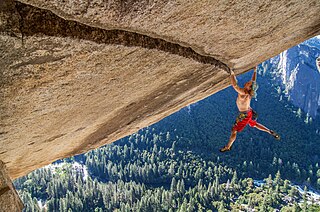
Climbing is the activity of using one's hands, feet, or other parts of the body to ascend a steep topographical object that can range from the world's tallest mountains to small boulders. Climbing is done for locomotion, sporting recreation, for competition, and is also done in trades that rely on ascension, such as rescue and military operations. Climbing is done indoors and outdoors, on natural surfaces, and on artificial surfaces

Mountaineering, mountain climbing, or alpinism is a set of outdoor activities that involves ascending mountains. Mountaineering-related activities include traditional outdoor climbing, skiing, and traversing via ferratas that have become sports in their own right. Indoor climbing, sport climbing, and bouldering are also considered variants of mountaineering by some, but are part of a wide group of mountain sports.

A climbing harness is a piece of equipment that allows a climber to tie in to the safety of a rope. It is used in rock and ice climbing, abseiling, and lowering; this is in contrast to other activities requiring ropes for access or safety such as industrial rope work, construction, and rescue and recovery, which use safety harnesses instead.
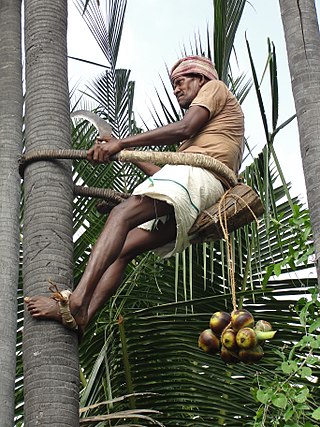
Tree climbing is a recreational or functional activity consisting of ascending and moving around in the crowns of trees.

Glossary of climbing terms relates to rock climbing, mountaineering, and to ice climbing.

Rock-climbing equipment varies with the type of climbing undertaken. Bouldering needs the least equipment outside of shoes and chalk and optional crash pads. Sport climbing adds ropes, harnesses, belay devices, and quickdraws to clip into pre-drilled bolts. Traditional climbing adds the need for carrying a "rack" of temporary passive and active protection devices. Multi-pitch climbing adds devices to assist in ascending and descending fixed ropes. Finally, aid climbing uses unique equipment.

A bouldering mat or crashpad is a nylon-enclosed multi-layer foam pad used for protection when bouldering. Bouldering mats help prevent climbers from injuring themselves from the continuous and repeated falls onto hard or uneven surfaces that are associated with projecting a bouldering problem.

Solo climbing, or soloing, is a style of climbing in which the climber climbs a route alone, without the assistance of a belayer. By its very nature, it presents a higher degree of risk to the climber, and in some cases, is considered extremely high risk.
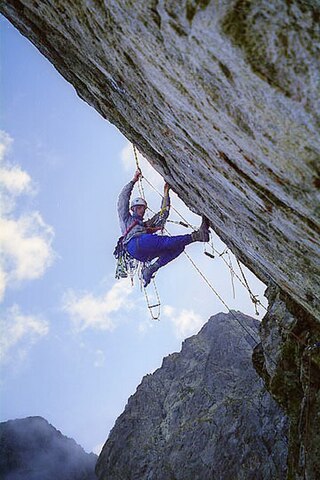
Aid climbing is a form of rock climbing that uses mechanical devices and equipment, such as aiders, for upward momentum. Aid climbing is different than free climbing, which only uses mechanical equipment for protection, but not to assist in upward momentum. Aid climbing sometimes involves hammering in permanent pitons and bolts, into which the aiders are clipped, but there is also 'clean aid climbing' which avoids any hammering, and only uses removable placements.
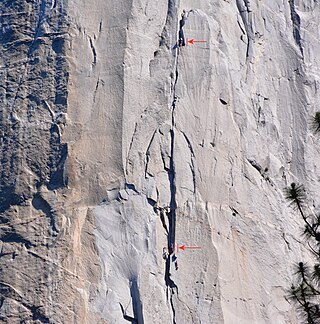
In climbing, a pitch is a section of a climbing route between two belay points, and is most commonly related to the task of lead climbing, but is also related to abseiling. Climbing on routes that require only one pitch is known as single-pitch climbing, and climbing on routes with more than one pitch is known as multi-pitch climbing.

Rock climbing is a sport in which participants climb up, across, or down natural rock formations or indoor climbing walls. The goal is to reach the summit of a formation or the endpoint of a usually pre-defined route without falling. Rock climbing is a physically and mentally demanding sport, one that often tests a climber's strength, endurance, agility and balance along with mental control. Knowledge of proper climbing techniques and the use of specialized climbing equipment is crucial for the safe completion of routes.
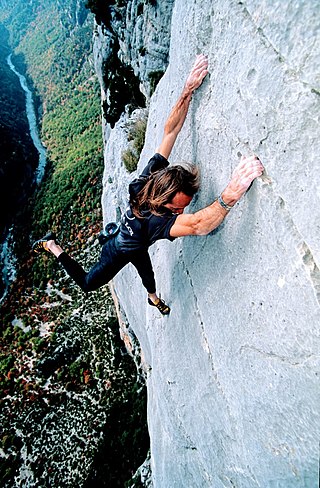
Free solo climbing, or free soloing, is a form of rock climbing where the climbers climb solo without ropes or other protective equipment, using only their climbing shoes and their climbing chalk. Free soloing is the most dangerous form of climbing, and, unlike bouldering, free soloists climb above safe heights, where a fall can be fatal. Though many climbers have free soloed climbing grades they are very comfortable on, only a tiny group free solo regularly, and at grades closer to the limit of their abilities.

Deep-water soloing (DWS), also known as psicobloc, is a form of free solo climbing where any fall should result in the climber landing safely into deep water below the route. DWS is therefore considered safer than normal free solo climbing, however, DWS brings several unique additional risks including trauma from uncontrolled high-speed water entry, injury from hitting hazards above and below the water while falling, and drowning in rough or tidal seas, and is thus considered riskier than normal bouldering.

A climbing rope is a rope that is used in climbing. It is a critical part of an extensive chain of protective equipment used by climbers to help prevent potentially fatal fall-related accidents.

A dynamic rope is a specially constructed, somewhat elastic rope used primarily in rock climbing, ice climbing, and mountaineering. This elasticity, or stretch, is the property that makes the rope dynamic—in contrast to a static rope that has only slight elongation under load. Greater elasticity allows a dynamic rope to more slowly absorb the energy of a sudden load, such from arresting a climber's fall, by reducing the peak force on the rope and thus the probability of the rope's catastrophic failure. A kernmantle rope is the most common type of dynamic rope now used. Since 1945, nylon has, because of its superior durability and strength, replaced all natural materials in climbing rope.
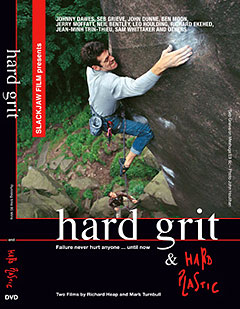
Hard Grit is a 1998 British rock climbing film directed by Richard Heap and produced by Slackjaw Film, featuring traditional climbing, free soloing, and bouldering on gritstone routes in the Peak District in Northern England. It is considered an important film in the genre and regarded as a historic and iconic film. The film starts with a dramatic fall by French climber Jean–Minh Trinh-Thieu on Gaia at Black Rocks. Hard Grit won ten international film festival awards.

Simul-climbing is a climbing technique where a pair of climbers who are attached by a rope simultaneously ascend a multi-pitch climbing route. It contrasts with lead climbing where the leader ascends a given pitch on the route while the second climber remains in a fixed position to belay the leader in case they fall. Simul-climbing is not free solo climbing, as the lead simul-climber will clip the rope into points of climbing protection as they ascend. Simul-climbing is different from a rope team and short-roping, which are used for flatter terrain that doesn't typically need protection points.
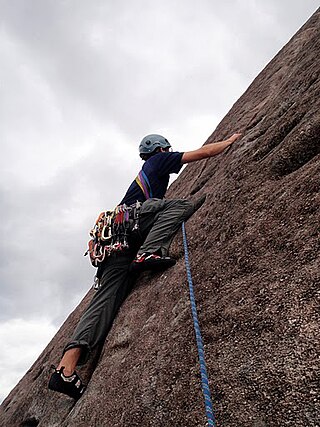
Slab climbing is a type of rock climbing where the rock face is at an angle less steep than vertical. It is characterized by balance- and friction-dependent moves on very small holds. It is often not leadable, or climbable from the ground up, unless it has pre-drilled bolts to protect the climb, making most slab climbs either top rope climbing or sport climbing. Special techniques such as smearing are necessary to climb slab. It is a type of face climbing and is distinctly different from crack climbing. Slab climbing is a relatively new area of climbing, having become more popular in the last 30 years, and some of the highest graded routes are currently being realized.

In climbing and mountaineering, a traverse is a section of a climbing route where the climber moves laterally, as opposed to in an upward direction. The term has broad application, and its use can range from describing a brief section of lateral movement on a pitch of a climbing route, to large multi-pitch climbing routes that almost entirely consist of lateral movement such as girdle traverses that span the entire rock face of a crag, to mountain traverses that span entire ridges connecting chains of mountain peaks.




















